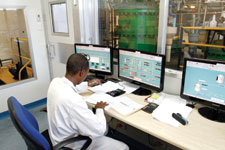
Tangible increases in productivity and consistency of product at LACSA.
A member of the Illovo Sugar Group, LACSA is a leading manufacturer of laxative ingredients for export and local consumption. As such, its processes and products are subject to stringent compliance to international regulations and guidelines, for example, the Food and Drug Administration of the USA (FDA). With an increased global demand for product, LACSA’s manually operated plant was placed under ever increasing pressure to meet production targets. In addition, quality was becoming problematic due to the human error associated with the production processes that relied on operator judgement for control.
Plant manager, Rodney Rogan, explains that the existing instrumentation provided indication only: “We had over 90 valves that had to be operated in a particular sequence for correct operation of the associated pumps. The manual systems had simply reached their limits.”

The Illovo Group, having already realised the benefits of automation, decided to implement such an approach at the LACSA plant. Because Illovo has been intimately involved with Cube Technologies for a number of years and trusts its judgement and capabilities implicitly, the decision to work hand in glove with Cube on the design and implementation of the project was taken easily.
Challenges
Vinesh Maharaj, GM sub-Saharan Africa for Cube Technologies, says the brief was to source, provide and implement all the equipment and software required for the upgrade: “The production department needed to increase throughput to meet demand, while QA required consistently high product quality with full traceability. Secondary objectives included the reduction and eventual elimination of batch documentation for the production area and the elimination of equipment damage due to incorrect operation.”
The solution, based on the Siemens PCS 7 DCS and Simatic Batch platform, was developed in-house with support from the local Siemens experts. “We also brought in a pharmaceutical consultant to assist with compliance to the FDA’s GAMP 5 guidelines for computer-based systems,” elaborates Maharaj.
“Our process involves stripping ions from the product by running it over resin filled columns which are then regenerated by performing acid and caustic washes followed by flushing with water,” explains Rogan. “Prior to this, the necessary batching operations are carried out by Simatic Batch using a toolkit and ANSI-C scripts from the DCS. This allows the operators to perform all the required functions associated with the process from within the PCS7 OS.”
“Batch numbers are incrementally generated by the DCS and it is possible for the operators to select a continuous mode of operation where the DCS will automatically start the next batch on completion of the current one without user intervention. This allows for a seamless transition between batches with zero stop time,” adds Maharaj.
Project meetings were held regularly and the frequency increased from once a month at the beginning of the project to daily during commissioning. Project management was carried out on MS Project Gannt Chart to track overall progress against the baseline.
“We learned some valuable lessons along the way,” says Rogan. “One of the things we realised is the importance of change management within the organisation to allay the understandable fears associated with automation. Once we addressed this our staff embraced the project and the upgrade has resulted in a 10 minute reduction in cycle times. This equates to a 10% saving in time that realises a significant saving in production costs. In addition, management now has more information to optimise and manage process by analysing alarms and trends.”
A service level agreement was signed with LACSA to provide 24/7 support and the LACSA team were trained on the software in-house as well as overseas.
“This is the first locally implemented Simatic Batch project in South Africa. There was a steep learning curve relating to batching and the requirements of GAMP 5 and the V-model approach to validation. The project was successfully implemented within the customer’s timelines and produced the required benefits in the first month after commissioning,” concludes Maharaj.
Cube Technologies’ company profile can be viewed at: http://www.instrumentation.co.za/36866n
For more information contact Vinesh Maharaj, Cube Technologies, +27 (0)31 764 6081, [email protected], www.cubetech.co.za

© Technews Publishing (Pty) Ltd | All Rights Reserved